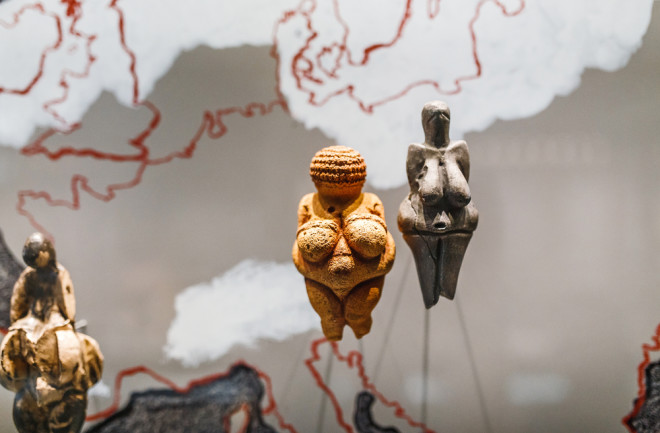In 1908 at an archeological dig site near Vienna, excavators uncovered a small stone statue depicting a woman. The statue was about four-inches tall, and it was painted a reddish color. The dig team cleaned it off, and in doing so, accidentally removed the red paint.
Scientists dubbed the statue the “Venus of Willendorf.” The Venus shows a faceless woman with her head tilted down. On her head, rows of jagged lines represent a hat or perhaps braids or curls. She has large breasts, an ample belly with an innie belly button and thick thighs, with no feet.
The statue has mystified researchers for more than a century. But now, they may have answered one question: where the statue originated.
Not a Venus
The Venus of Willendorf is a bit of misnomer because it was carved thousands of years before ancient Romans celebrated Venus, the goddess of fertility, love and beauty. The Venus of Willendorf was carved more than 30,000 years ago, too early to be related to the Roman goddess.
The Venus also didn’t originate in Willendorf, the Austrian village where it was eventually unearthed. The statue was carved from limestone, a sedimentary rock not found in the area. For more than a century since the statue was discovered, researchers have debated what the statue meant and where it was from.
More facts about the Venus of Willendorf:
The statue is roughly 30,000 years old.
Across Europe, nearly 200 similar statuettes have surfaced from sites.
It’s unclear why Ice Age people carved these figurines.
A 2022 study in Scientific Reports study used 3-D technology to scan the statue and see inside. The researchers found the statue was made of oolitic limestone. They could then analyze the statue’s internal structures and compare it to rock samples from elsewhere in Europe.
Before this study, researchers have long considered that the raw material used to carve the statue might have come from modern day Ukraine or Czech Republic. But when they compared the Venus statue with samples from those regions, the authors saw similarities with the Ukrainian material, but not the Czech.
The most significant similarities appeared in the samples from Northern Italy, and the study’s authors believe the raw material used to carve the Venus came from south of The Alps. This means the statue was either carved in what is now modern-day Italy and then carried north, or the raw material was moved and later carved in Austria.
Such movement gives researchers a better idea about the lives of the Gravettian people who lived in Europe during the Ice Age.
Ice Queen
The Venus of Willendorf was one of many statues made during the Ice Age that depicted a nude, thick woman. The Gravettian people, who lived in Europe during this time, were hunters and gathers and eventually spread across the European continent.
Historians have long thought the Gravettian people were homogeneous, despite ranging from Southern to Central Europe.
Read more: The 6 Most Iconic Ancient Artifacts That Continue to Captivate
A 2020 study in Scientific Reports supported the idea that the Gravettians had a shared culture. The team used 3-D technology to scan and analyze skulls. They found little variation, which was consistent with other studies that found the Gravettians had a similar biological makeup.
Some scholars believe the Gravettians originated in Central Europe and then made their way down to the Iberian and Italian peninsulas. They didn’t move fast, and likely only advanced an average of one kilometer per year. They also may not have encountered others during the slow migration, and scholars think Europe had a small hominin population at the time.
Archeologists continue to learn about people who lived during this time, and they have found evidence that the Gravettians shared a symbolic culture. Funeral practices, cave art, and objects found across Europe from this time period were thought to share symbolic qualities, although modern researchers have not understood the meaning. These reoccurring symbols, however, suggest Gravettians maintained a network, which allowed for the sharing of ideas and technologies.
And for the Venus of Willendorf, more than 200 similar statues have been unearthed. The material differs, and although most were made with limestone, a few were carved into ivory. The Venus of Willendorf was unique because it was made of oolitic limestone, which researchers have not seen in other female statues from that time period.
Mysterious Meaning
It’s difficult to know the values of people who lived 30,000 years ago and what their symbols meant. Given the quantity of Venus artifacts found throughout the European continent, it’s evident the statue had a shared significance among the Gravettians.
Read more: What Did the Venus of Willendorf Originally Represent?
Some scholars think the Venus statues related to fertility. The Venus had ample breasts and could be perceived as a pregnant or nursing mother. Others saw the Venus statues as erotic. The Gravettians lived during the Ice Age, when the climate was inhospitable and excess body fat was not common and therefore appreciated. The Venus, with its fleshy butt and ample stomach would have been the unobtainable body standard for women of the day.
In a 2011 article in the Journal of Archeology, the authors suggested an alternative reading. They viewed the Venus as having a more mature body, and possibly one of a middle-aged woman. The body was well-nourished and showed the signs of past pregnancies. To Gravettian people, this might have been viewed as an accomplishment, and the statue could have been a symbol of hope, survival, and longevity.
Other scholars argue that not only will we never fully know the meaning of the statue, our interpretations will always be fogged by our own biases. It’s simply too hard to go back in time and not take along our modern worldview.

